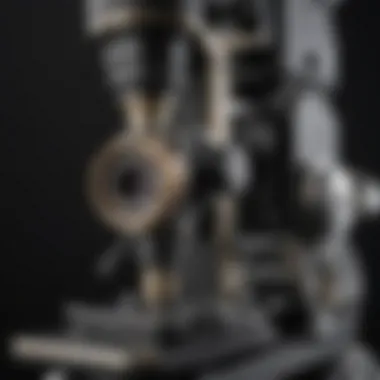Comprehensive Overview of the Alexis Microscope


Research Overview
The Alexis scientific microscope represents a notable innovation in microscopy. Its design and technology serve as a bridge between classical approaches and modern research demands. Understanding its capabilities requires a thorough examination of its methodological approaches, its significance, and practical implications in various fields.
Methodological Approaches
The design of the Alexis microscope integrates advanced optical systems with digital imaging technology. This combination allows researchers to visualize samples in unprecedented detail. The microscope's automated features streamline the observation process, making it efficient in laboratory settings.
For example, the integration of fluorescence microscopy allows for the observation of specific features within a sample. By using fluorescent markers, scientists can track cellular processes, enhancing the understanding of biological functions. Additionally, the ability to conduct live cell imaging has opened new frontiers in the study of dynamic biological events.
Significance and Implications
The significance of the Alexis microscope goes beyond its technical specifications. It plays a vital role in various scientific disciplines. In biology, for instance, its capabilities facilitate research in cellular biology, molecular dynamics, and genetic studies. This microscope allows for an accurate examination of structures, contributing to breakthroughs in various fields such as cancer research and drug development.
The implications of utilizing the Alexis microscope extend to practical applications in educational settings as well. Among students and educators, it serves as a powerful tool for teaching complex concepts in science. By enabling students to visualize biological processes, it enhances comprehension and fosters a deeper interest in scientific inquiry.
"The Alexis scientific microscope not only enhances research capabilities but also serves as a crucial educational tool, bridging theory and practice."
Current Trends in Science
Recent advancements in microscopy have reshaped the landscape of scientific exploration. The Alexis microscope is at the forefront of these changes, offering innovative techniques and fostering interdisciplinary connections.
Innovative Techniques and Tools
Emphasizing the use of cutting-edge imaging technologies, the Alexis microscope incorporates machine learning algorithms. These algorithms assist in image analysis, allowing for greater precision in identifying features within complex samples. Such innovations save time and increase the accuracy of research findings.
Moreover, this microscope is designed to be compatible with various imaging techniques, including confocal and electron microscopy. This flexibility encourages researchers from different domains to collaborate and share insights, thus fostering innovation.
Interdisciplinary Connections
As scientific research becomes increasingly interconnected, the role of the Alexis microscope becomes more pronounced. Its applications span multiple fields, including biology, materials science, and nanotechnology. This ability to cross over disciplinary boundaries enhances collaboration and sparks new avenues for exploration.
In summary, the Alexis scientific microscope is not merely a tool for observation. It represents a shift towards a more integrated and efficient approach to scientific research. By understanding its design, functionality, and applications, researchers and educators can leverage its capabilities to further their studies and enrich the learning environment.
Prelude to Alexis Scientific Microscope
The Alexis Scientific Microscope represents a significant advancement in the field of microscopy, providing researchers with powerful tools that enhance their ability to analyze and interpret microscopic details. This article aims to provide a comprehensive overview of the Alexis scientific microscope, with a focus on its design, functionality, and various applications in today’s scientific community.
Understanding the Alexis Scientific Microscope is crucial for anyone involved in scientific research, education, or various applications in biological or material sciences. Through an exploration of its features, historical context, and technical specifications, readers can gain insight into how this device contributes to scientific inquiry.
Definition and Purpose
The Alexis Scientific Microscope is a device designed to magnify small objects for detailed examination. Its primary purpose is to enhance the visibility of microscopic structures, allowing users to observe and analyze specimens that would be otherwise invisible to the naked eye. The microscope achieves this through a combination of lenses and lighting systems that work in tandem to create clear, magnified images.
In contemporary research settings, the Alexis Scientific Microscope serves various functions, such as enabling scientists to study cellular structures, evaluate material properties, and conduct environmental analyses. This versatility makes it an indispensable tool in laboratories and educational institutions.
Historical Context
The development of microscopes has a rich history that spans several centuries. The Alexis Scientific Microscope falls within a lineage of optical instruments that have evolved from rudimentary lenses to sophisticated devices capable of extraordinary detail. The initial designs of microscopes date back to the late 16th century, with pioneering figures like Antonie van Leeuwenhoek contributing to the early advancements by refining lens quality and magnification techniques.
As technology progressed, so too did the complexity of microscopes. The Alexis model showcases a culmination of innovations, integrating digital technology and enhanced optical systems. These advancements cater to the demands of modern science, where accuracy and clarity in observation are paramount. The historical context of microscope development illustrates the trajectory of scientific progress and highlights the Alexis Scientific Microscope's place within this continuous evolution.
Understanding the past of microscopy can enhance the appreciation of current technologies, showing how far we've come in uncovering the microscopic world.
Design Features
The design features of the Alexis scientific microscope are pivotal for its performance in various scientific fields. These elements encapsulate the intricate balance between functionality, user-friendliness, and aesthetics. Understanding these design aspects is essential not only for current users but also for those considering the microscope for future projects.
Optical System


The optical system is a fundamental part of any microscope, and the Alexis microscope excels in this area. It utilizes advanced optical components which contribute to the overall clarity and detail of the images produced. Key aspects of the optical system include:
- High-quality lenses that minimize distortion and maximize resolution.
- Multi-coated optics to enhance light transmission and reduce glare.
- An adjustable objective lens system allowing for various magnification levels.
These features directly impact the user’s ability to observe specimens in great detail. Moreover, the optical design helps in providing a more accurate representation of the sample, which is crucial in scientific research and diagnostics.
Mechanical Components
The construction of mechanical components in the Alexis microscope determines its durability and reliability. It incorporates robust materials designed to withstand the rigors of laboratory use. Significant features include:
- Sturdy frame for stability during use, which is essential for high-magnification work.
- Precision focus mechanism for fine adjustments without unnecessary movement.
- Smooth stage movement for easy positioning of slides.
These components significantly enhance the user experience by ensuring consistent functionality over time. Reliability in mechanical operations allows researchers to focus on their observations without the distraction of equipment failure.
Ergonomics and User Interface
User experience plays a key role in the effectiveness of the Alexis microscope. The ergonomic design ensures that it can be used comfortably for extended periods. Important details include:
- Adjustable eyepiece height and angle for better visual comfort based on user preference.
- Intuitive controls that simplify operational procedures, making it easier for novices to learn.
- Minimalistic yet informative interface that provides all necessary adjustments without overwhelming the user.
This attention to ergonomic detail not only prevents user fatigue but also enhances overall efficiency in the laboratory setting. Ultimately, a well-designed user interface allows for quicker adaptability and proficiency, especially important in dynamic research environments.
Technical Specifications
The technical specifications of the Alexis scientific microscope form the backbone of its operational capacity. These specifications not only indicate the functionality but also the versatility of the instrument in diverse fields. Understanding these specifications will guide users in selecting the right configuration for their specific needs, ensuring optimal performance in laboratory settings, educational environments, or field studies.
Magnification Capabilities
Magnification is a crucial aspect of any microscope, and the Alexis model stands out with its multiple magnification settings. Typically, the Alexis microscope can achieve magnifications of up to 1000x with standard eyepieces and objectives. This flexibility allows for detailed exploration of cellular structures and materials that would otherwise remain invisible to the naked eye. Users can switch between eyepieces and objectives easily, which enhances the practical application of the instrument in both research and educational settings.
Maintaining a clear magnified image requires consideration of additional factors, such as the type of objectives used and the quality of the lenses. The Alexis microscope employs high-quality optics that mitigate distortion at higher magnifications, promoting accurate visual analysis. This capability makes it ideal for studying fine details in biological specimens and materials.
Resolution and Clarity
Resolution defines the microscope's ability to distinguish between two closely spaced objects. For the Alexis microscope, a high resolution is paramount, typically rated at about 0.2 micrometers. This level of clarity is vital for researchers who require precise delineation between structures, particularly in microbiology or histology.
The construction of the Alexis microscope includes advanced lens systems that outperform traditional microscopes in terms of resolution. A high numerical aperture contributes to improved light-gathering ability, thereby enhancing the resulting clarity of the image. Users find that even at high magnification, the Alexis microscope produces sharp, clear images that facilitate rigorous analysis. Clear images lead to more accurate results in data collection and interpretation, directly impacting research outcomes.
Lighting Systems
Lighting is integral to effective microscopy. The Alexis microscope incorporates modern lighting systems, such as LED illumination, which provide consistent and adjustable brightness levels. This feature enhances image contrast and detail, allowing specimens to be visualized effectively at various magnifications.
The Alexis microscope also supports multiple lighting techniques, including bright field, dark field, and phase contrast illumination. This versatility enables users to explore specimens under different conditions, catering to a wide range of microscopy applications. For example, phase contrast is particularly useful for viewing live cells without staining, preserving their natural state.
In addition, the energy efficiency of LED systems reduces heat generation, protecting both the specimens and the microscope's internal components. By implementing reliable and diverse lighting options, Alexis ensures users can adapt to the specific requirements of various research fields.
"The Alexis scientific microscope exemplifies the perfect blend of precision and versatility, essential for any rigorous scientific inquiry."
In summary, the technical specifications of the Alexis microscope significantly elevate its role in research and education. These features operate cohesively to provide users with a powerful tool for discovering and analyzing the microscopic world.
Comparative Analysis
Comparative analysis is critical in understanding the place of the Alexis scientific microscope in today's research landscape. By contrasting it with other types of microscopes, one can assess its unique contributions and limitations within the realm of scientific inquiry. This analysis not only helps establish a foundation for users to make informed decisions but also highlights the strengths and shortcomings of the Alexis design. Through this lens, we can appreciate its relevance across varying scientific disciplines, thus empowering researchers and educators alike to select the most suitable tool for their specific needs.
Alexis vs. Traditional Microscopes
When we examine the differences between Alexis and traditional microscopes, several key factors become apparent. Traditional microscopes, such as light microscopes, have been foundational in biological research. They utilize visible light and glass lenses to magnify samples. Alexis, on the other hand, incorporates advanced optics and technology to enhance visualization results.
- Optical Clarity: Alexis microscopes often provide superior resolution compared to traditional models. This aspect proves critical in microbiology, where precise visualization of cellular structures is necessary.
- Ease of Use: Alexis systems usually incorporate user-friendly interfaces. This reduces the learning curve for new users, contrasting with traditional microscopes that may require more technical expertise.
- Imaging Technology: Traditional microscopes frequently lack capabilities for high-definition digital imaging. Alexis models often include digital features, allowing for seamless sharing and analysis of images.


Overall, while traditional microscopes have their established roles, the advancements present in the Alexis microscope foster a more intuitive and effective research experience.
Alexis vs. Digital Microscopes
The digital microscopy domain has evolved rapidly, introducing tools that bear similarities to the Alexis model. Both employ sensors and digital displays, yet there remain distinct differences that merit attention.
- Image Processing: Alexis microscopes often feature sophisticated software that enhances image quality. While many digital microscopes also provide image processing, the algorithms and adaptability of Alexis technology set it apart.
- Versatility: Alexis systems maintain compatibility with various sample types, making them valuable in diverse research fields. Digital microscopes may have limitations based on design or proprietary software, impacting how they can be applied in studies.
- Cost Implications: Generally, digital microscopes can be more affordable. However, the cost of a higher-end Alexis system can be justified by its superior functionality, especially in research environments demanding high precision.
In summary, while both types of microscopes aim to enhance viewing experiences, the differences in processing capabilities and versatility position Alexis as a robust alternative in the competitive digital microscopy landscape.
Advantages and Limitations
Understanding both the advantages and limitations of the Alexis microscope can help users adapt their methods to leverage its strengths effectively.
Advantages:
- Enhanced Resolution: Provides clarity on microscopic structures that is crucial for advanced research.
- User-Friendly: Simplifies complex tasks, allowing researchers to focus more on analysis rather than instrument operation.
- Wide Applications: Suitable for diverse scientific fields, including biology, materials science, and environmental studies.
Limitations:
- Cost Factor: May represent a more significant investment than some traditional or digital models.
- Training Necessity: Although easier to use, some degree of training might still be needed to fully exploit its capabilities.
By balancing these advantages and limitations, researchers can optimize their use of the Alexis microscope to suit their specific investigative needs.
Applications in Research
The Alexis scientific microscope plays a pivotal role in the research landscape by providing unparalleled insight into various microscopic phenomena. Researchers across various disciplines utilize this instrument not only to enhance their understanding of complex biological structures but also to innovate solutions in areas like material science and environmental monitoring. This section aims to unravel the importance of the Alexis microscope in research applications, illustrating specific advantages, practical considerations, and its broader impact on scientific inquiry.
Biological Sciences
In the realm of biological sciences, the Alexis microscope serves as a fundamental tool for examining cellular structures, tissues, and microorganisms. Its advanced optical capabilities allow scientists to visualize minute details of cells, facilitating groundbreaking discoveries in genetics, microbiology, and cellular biology. For instance, researchers can study the effects of diseases at the cellular level through high-resolution imaging, which enables the identification of cellular anomalies and potential treatments.
Key benefits include:
- Enhanced Resolution: The microscope's superior optical design provides high clarity, allowing the distinction of fine cellular details.
- Versatile Imaging Options: Different lighting systems, such as phase contrast and fluorescence microscopy, expand the capabilities for studying various biological specimens.
- Real-Time Observation: The ability to observe live cells enhances research on cellular behavior under different conditions.
As a result, the Alexis microscope not only accelerates research efforts but also contributes to the development of new medical therapies and biotechnologies.
Material Science
In material science, the Alexis microscope is invaluable for analyzing materials at the microscopic level. Its application ranges from the examination of metals and polymers to the study of nanostructures. Detailed analysis of material properties helps in understanding their composition, structure, and subsequent performance.
Applications in this field include:
- Microstructural Analysis: The microscope allows researchers to study grain boundaries, phase distributions, and other microstructural features in solid materials.
- Quality Control: Regular use of the microscope in labs ensures that materials meet strict quality standards by detecting defects or inconsistencies.
- R&D for New Materials: Insights gained through microscopy can lead to the development of innovative materials with desired properties for industries such as manufacturing and aerospace.
Thus, the Alexis microscope is essential for enhancing the quality and performance of materials through informed design and analysis.
Environmental Studies
Environmental science greatly benefits from the capabilities of the Alexis microscope, particularly in the analysis of pollutants, microorganisms, and ecological interactions. This instrument assists researchers in monitoring environmental changes and assessing the health of ecosystems.
Critical uses in environmental studies include:
- Pollution Analysis: Microscopy is employed to identify and quantify pollutants, such as heavy metals and microplastics, in soil and water samples.
- Biodiversity Studies: Researchers can study microbial communities, providing insights into ecosystem health and biodiversity.
- Impact Assessments: Understanding the interactions between organisms and their environments is crucial for environmental impact assessments, especially in ecological conservation projects.
With the growing concern for environmental sustainability, the Alexis microscope emerges as a vital tool for investigating ecological issues and informing policy decisions that affect ecosystems globally.
"The Alexis scientific microscope not only enhances our understanding of the microscopic world but also drives innovation across multiple research domains, reflecting the interconnected nature of modern scientific inquiry."


In summary, the applications of the Alexis microscope in research are extensive and impactful. By enabling detailed examination of biological specimens, analysis of materials, and investigation of environmental issues, it underscores its importance within various scientific fields.
Practical Considerations
Practical considerations when using the Alexis scientific microscope are essential to ensure effective operation and longevity. This section highlights setup, maintenance, and proper handling of samples, providing clear guidance. Understanding these aspects can significantly improve user experience and outcomes in various research fields.
Setup and Configuration
Setting up the Alexis microscope involves several key steps that must be followed to achieve optimal performance. First, choose a stable workstation that minimizes vibrations. This will help maintain the microscope's precision. Next, level the base using the built-in adjustment mechanism. A properly leveled microscope offers more accurate results.
Then, connect the light source, ensuring it matches the microscope's requirements for illumination. The optical components should be clean and free from dust. Before initial use, calibrating magnification settings is crucial.
Following the basic setup, users must familiarize themselves with the operating manual. It details the specifics of each component, allowing for easier adjustments during use. This setup ensures a smoother workflow, ultimately enhancing research reliability.
Maintenance and Care
Ongoing maintenance is vital for the Alexis microscope. Regular cleaning of lenses and optical components with appropriate solutions helps preserve sharpness and clarity. Avoid using harsh chemicals that can damage coatings. Instead, use lint-free wipes for best results.
In addition to cleaning, checking the mechanical components on a schedule is beneficial. Lubricating moving parts prevents wear and tear. It also maintains smooth operation, reducing the likelihood of errors during observations.
Regular maintenance not only extends the life of the microscope but also ensures consistent performance that researchers depend on.
Furthermore, proper storage is an often-overlooked aspect. When not in use, placing the microscope in a protective case will shield it from dust and potential impacts. Keeping the instruments calibrated and in top condition reflects a high standard of professional practice.
Handling Samples
Samples are the heart of microscopy, and handling them correctly is crucial. First, always use clean tools to avoid contamination. Tweezers or gloves can minimize transfer of oils or dirt from hands to samples.
Using appropriate slides designed for the Alexis microscope ensures compatibility. Be cautious when placing samples on slides to avoid air bubbles that could distort views. An organized sample management system aids in maintaining clarity during experiments, saving valuable research time.
Finally, proper disposal of biological samples must follow institutional and legal guidelines to maintain safety and ethics in research. Adopting these practices not only promotes reliability but also contributes to the credibility of research findings.
Future Developments
The field of microscopy stands at the precipice of significant change, particularly with the advancements that the Alexis scientific microscope promises to bring. Understanding future developments is crucial for stakeholders, including researchers and educators, as these innovations can shape the trajectory of scientific exploration and discovery. By delving into the potential of technological advancements and their subsequent impacts on research, this section aims to provide an insightful analysis of what's forthcoming in microscopy.
Technological Advancements
Continual advancements in technology are transforming the way microscopes operate. The Alexis scientific microscope is no exception, with several innovations on the horizon. Here are some significant areas of development:
- Enhanced Imaging Techniques: Improvements in imaging technology, such as super-resolution microscopy, enable scientists to visualize samples at the molecular level. This promises to yield more detailed images than ever before, enhancing research capabilities in various fields.
- Integration with AI: Artificial Intelligence can streamline processes such as image analysis. AI algorithms can assist in identifying patterns or anomalies within complex data sets, simplifying the data interpretation process.
- Portability and Accessibility: Advances in materials and design could lead to lighter, more compact microscopes without sacrificing performance. This accessibility can encourage use outside traditional laboratories, facilitating research in diverse environments.
These advancements not only improve the functionality of the Alexis microscope but may also redefine how its users engage with their research.
Potential Impacts on Research
The prospective developments in microscopy technology promise profound implications for research across disciplines. Here are some ways these advancements might affect the scientific community:
- Increased Efficiency: With enhanced imaging and better data analysis tools, researchers can achieve results more efficiently. This can lead to accelerated discovery times, benefitting academia and industry alike.
- Broader Applications: The ability to analyze samples at finer resolutions can open new fields for exploration, such as nanotechnology or advanced material sciences. Research inquiries can expand into previously unreachable domains, fostering innovation.
- Collaboration Opportunities: Enhanced microscope capabilities can lead to interdisciplinary collaboration. For example, biologists working alongside computer scientists can analyze biological samples using new imaging technologies, leading to groundbreaking findings.
"The future of microscopy rests on the integration of sophisticated technologies that can significantly expedite and expand the research landscape."
End
In this exploration of the Alexis scientific microscope, it becomes clear how this instrument intertwines design, functionality, and research applications within the scientific community. The significance of the conclusion lies in synthesizing the various dimensions of the microscope and its impact on scientific inquiry.
Summary of Key Points
The Alexis microscope stands out for several reasons:
- Advanced optical systems allow greater clarity and magnification.
- User-friendly designs make it accessible for both novices and seasoned researchers.
- Applications across diverse fields, including biological sciences and material science, demonstrate its versatility.
- Comparative advantages over traditional and digital microscopes highlight its unique benefits.
- Future developments signal potential enhancements that could further impact research practices.
Final Thoughts
As we conclude, it is important to recognize that the Alexis scientific microscope serves not only as a tool but also as a bridge between curiosity and discovery. Its design intricacies and technical specifications underscore a commitment to precision and reliability. As research continues to evolve, the role of such instruments will be crucial in advancing our understanding of the microscopic world. In this light, engaging with the capabilities of the Alexis microscope is not simply about operational knowledge, but about embracing the possibilities it presents in the grand narrative of scientific exploration.



